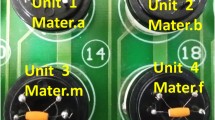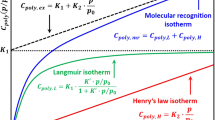Abstract
Gas sensor arrays often lack discrimination power to different analytes and robustness to interferants, limiting their success outside of research laboratories. This is primarily due to the widely sensitive (thus weakly-selective) nature of the constituent sensors. Here, the effect of orthogonality on array accuracy and precision by selective sensor design is investigated. Therefore, arrays of (2–5) selective and non-selective sensors are formed by systematically altering array size and composition. Their performance is evaluated with 60 random combinations of ammonia, acetone and ethanol at ppb to low ppm concentrations. Best analyte predictions with high coefficients of determination (R2) of 0.96 for ammonia, 0.99 for acetone and 0.88 for ethanol are obtained with an array featuring high degree of orthogonality. This is achieved by using distinctly selective sensors (Si:MoO3 for ammonia and Si:WO3 for acetone together with Si:SnO2) that improve discrimination power and stability of the regression coefficients. On the other hand, arrays with collinear sensors (Pd:SnO2, Pt:SnO2 and Si:SnO2) hardly improve gas predictions having R2 of 0.01, 0.86 and 0.28 for ammonia, acetone and ethanol, respectively. Sometimes they even exhibited lower coefficient of determination than single sensors as a Si:MoO3 sensor alone predicts ammonia better with a R2 of 0.68.

Conventional arrays (red) with weakly-selective sensors span a significantly smaller volume in the analyte space than arrays containing distinctly-selective sensors (orthogonal array, green). Orthogonal arrays feature better accuracy and precision than conventional arrays in mixtures of ammonia, acetone and ethanol.





Similar content being viewed by others
References
Persaud K, Dodd G (1982) Analysis of discrimination mechanisms in the mammalian olfactory system using a model nose. Nature 299(5881):352–355. https://doi.org/10.1038/299352a0
Röck F, Barsan N, Weimar U (2008) Electronic nose: current status and future trends. Chem Rev 108(2):705–725. https://doi.org/10.1021/cr068121q
Ragazzo-Sanchez JA, Chalier P, Chevalier D, Ghommidh C (2006) Electronic nose discrimination of aroma compounds in alcoholised solutions. Sensors Actuators B Chem 114(2):665–673. https://doi.org/10.1016/j.snb.2005.05.032
Phillips M (2005) Can the electronic nose really sniff out lung cancer? Am J Respir Crit Care Med 172(8):1060; author reply 1060-1061–1061. https://doi.org/10.1164/ajrccm.172.8.959
Pizzini A, Filipiak W, Wille J, Ager C, Wiesenhofer H, Kubinec R, Blaško J, Tschurtschenthaler C, Mayhew CA, Weiss G, Bellmann-Weiler R (2018) Analysis of volatile organic compounds in the breath of patients with stable or acute exacerbation of chronic obstructive pulmonary disease. J Breath Res 12(3):036002. https://doi.org/10.1088/1752-7163/aaa4c5
Güntner AT, Koren V, Chikkadi K, Righettoni M, Pratsinis SE (2016) E-nose sensing of low-ppb formaldehyde in gas mixtures at high relative humidity for breath screening of lung cancer? ACS Sens 1(5):528–535. https://doi.org/10.1021/acssensors.6b00008
Sundgren H, Winquist F, Lukkari I, Lundstrom I (1991) Artificial neural networks and gas sensor arrays - quantification of individual components in a gas-mixture. Meas Sci Technol 2(5):464–469. https://doi.org/10.1088/0957-0233/2/5/008
Carey WP, Beebe KR, Sanchez E, Geladi P, Kowalski BR (1986) Chemometric analysis of multisensor arrays. Sensors Actuators 9(3):223–234. https://doi.org/10.1016/0250-6874(86)80023-3
Pearce TC, Schiffman SS, Nagle HT, Gardner JW (2003) Handbook of machine olfaction: electronic nose technology. WiILEY-VCH, Weinheim. https://doi.org/10.1002/3527601597
Joshi N, Hayasaka T, Liu YM, Liu HL, Oliveira ON, Lin LW (2018) A review on chemiresistive room temperature gas sensors based on metal oxide nanostructures, graphene and 2D transition metal dichalcogenides. Microchim Acta 185(4):213. https://doi.org/10.1007/s00604-018-2750-5
Righettoni M, Tricoli A, Gass S, Schmid A, Amann A, Pratsinis SE (2012) Breath acetone monitoring by portable Si:WO3 gas sensors. Anal Chim Acta 738:69–75. https://doi.org/10.1016/j.aca.2012.06.002
Güntner AT, Pineau NJ, Chie D, Krumeich F, Pratsinis SE (2016) Selective sensing of isoprene by Ti-doped ZnO for breath diagnostics. J Mater Chem B 4(32):5358–5366. https://doi.org/10.1039/C6TB01335J
Güntner AT, Righettoni M, Pratsinis SE (2016) Selective sensing of NH3 by Si-doped α-MoO3 for breath analysis. Sens Actuators B Chem 223:266–273. https://doi.org/10.1016/j.snb.2015.09.094
Güntner AT, Sievi NA, Theodore SJ, Gulich T, Kohler M, Pratsinis SE (2017) Noninvasive body fat burn monitoring from exhaled acetone with Si-doped WO3-sensing nanoparticles. Anal Chem 89(19):10578–10584. https://doi.org/10.1021/acs.analchem.7b02843
Güntner AT, Pineau NJ, Mochalski P, Wiesenhofer H, Agapiou A, Mayhew CA, Pratsinis SE (2018) Sniffing entrapped humans with sensor arrays. Anal Chem 90(8):4940–4945. https://doi.org/10.1021/acs.analchem.8b00237
Mädler L, Roessler A, Pratsinis SE, Sahm T, Gurlo A, Barsan N, Weimar U (2006) Direct formation of highly porous gas-sensing films by in situ thermophoretic deposition of flame-made Pt/SnO2 nanoparticles. Sens Actuators B Chem 114(1):283–295. https://doi.org/10.1016/j.snb.2005.05.014
Tricoli A, Graf M, Pratsinis SE (2008) Optimal doping for enhanced SnO2 sensitivity and thermal stability. Adv Funct Mater 18(13):1969–1976. https://doi.org/10.1002/adfm.200700784
Mädler L, Sahm T, Gurlo A, Grunwaldt JD, Barsan N, Weimar U, Pratsinis SE (2006) Sensing low concentrations of CO using flame-spray-made Pt/SnO2 nanoparticles. J Nanopart Res 8(6):783–796. https://doi.org/10.1007/s11051-005-9029-6
Davies S, Spanel P, Smith D (1997) Quantitative analysis of ammonia on the breath of patients in end-stage renal failure. Kidney Int 52(1):223–228. https://doi.org/10.1038/ki.1997.324
Diskin AM, Spanel P, Smith D (2003) Time variation of ammonia, acetone, isoprene and ethanol in breath: a quantitative SIFT-MS study over 30 days. Physiol Meas 24(1):107–119. https://doi.org/10.1088/0967-3334/24/1/308
Mardia KV, Kent JT, Bibby JM (1979) Multivariate analysis. Academic Press, Cambridge
James G, Witten D, Hastie T, Tishirani R (2013) An introduction to statistical learning. Springer, Heidelberg. https://doi.org/10.1007/978-1-4614-7138-7
Pratsinis SE (2010) Aerosol-based technologies in nanoscale manufacturing: from functional materials to devices through core chemical engineering. AICHE J 56(12):3028–3035. https://doi.org/10.1002/aic.12478
Gardner JW (1989) A diffusion-reaction model of electrical-conduction in tin oxide gas sensors. Semicond Sci Technol 4(5):345–350. https://doi.org/10.1088/0268-1242/4/5/003
van den Broek J, Güntner AT, Pratsinis SE (2018) Highly selective and rapid breath isoprene sensing enabled by activated alumina filter. ACS Sens 3(3):677–683. https://doi.org/10.1021/acssensors.7b00976
Güntner AT, Abegg S, Wegner K, Pratsinis SE (2018) Zeolite membranes for highly selective formaldehyde sensors. Sens Actuators B Chem 257:916–923. https://doi.org/10.1016/j.snb.2017.11.035
McCartney MM, Zrodnikov Y, Fung AG, LeVasseur MK, Pedersen JM, Zamuruyev KO, Aksenov AA, Kenyon NJ, Davis CE (2017) An easy to manufacture micro gas preconcentrator for chemical sensing applications. ACS Sens 2(8):1167–1174. https://doi.org/10.1021/acssensors.7b00289
Itoh T, Miwa T, Tsuruta A, Akamatsu T, Izu N, Shin W, Park J, Hida T, Eda T, Setoguchi Y (2016) Development of an exhaled breath monitoring system with semiconductive gas sensors, a gas condenser unit, and gas chromatograph columns. Sensors 16(11). https://doi.org/10.3390/s16111891
Anderson JC (2015) Measuring breath acetone for monitoring fat loss: review. Obesity 23(12):2327–2334. https://doi.org/10.1002/oby.21242
Smith D, Turner C, Spanel P (2007) Volatile metabolites in the exhaled breath of healthy volunteers: their levels and distributions. J Breath Res 1(1):014004. https://doi.org/10.1088/1752-7155/1/1/014004
McAleer JF, Moseley PT, Norris JOW, Williams DE, Taylor P, Tofield BC (1987) Tin oxide based gas sensors. Mater Chem Phys 17(6):577–583. https://doi.org/10.1016/0254-0584(87)90017-4
Gardner JW, Boilot P, Hines EL (2005) Enhancing electronic nose performance by sensor selection using a new integer-based genetic algorithm approach. Sens Actuators B Chem 106(1):114–121. https://doi.org/10.1016/j.snb.2004.05.043
Olive DJ (2017) Linear regression. Springer, Heidelberg. https://doi.org/10.1007/978-3-319-55252-1
Harrell FE (2001) Regression Modeling Strategies. Springer series in statistics. Springer, Heidelberg. https://doi.org/10.1007/978-1-4757-3462-1
King G (1986) How not to lie with statistics - avoiding common mistakes in quantitative political-science. Am J Polit Sci 30(3):666–687. https://doi.org/10.2307/2111095
Acknowledgments
This study was financially supported by the Swiss National Science Foundation (Grant No.170729 & 159763) and by an ETH Research Grant (No. ETH-21 18-1).
Author information
Authors and Affiliations
Corresponding author
Ethics declarations
The author(s) declare that they have no competing interests.
Electronic supplementary material
ESM 1
(DOCX 5.86 mb)
Rights and permissions
About this article
Cite this article
Pineau, N.J., Kompalla, J.F., Güntner, A.T. et al. Orthogonal gas sensor arrays by chemoresistive material design. Microchim Acta 185, 563 (2018). https://doi.org/10.1007/s00604-018-3104-z
Received:
Accepted:
Published:
DOI: https://doi.org/10.1007/s00604-018-3104-z




